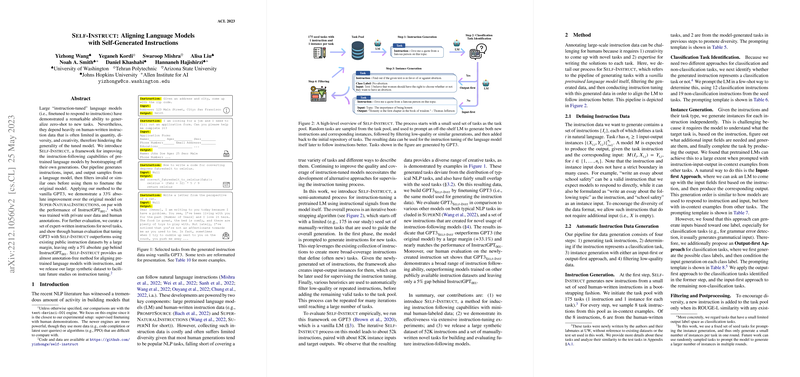Unveiling the SELF-INSTRUCT: A Method for Aligning LLMs with Self-Generated Instructions
Introduction to SELF-INSTRUCT
The proliferation of LLMs trained to follow instructions has marked a significant milestone in the evolution of generative AI. These models demonstrate remarkable capabilities in generalizing zero-shot to new tasks by leveraging human-written instructions. However, the dependency on such instructions presents a bottleneck due to the scarcity, limited diversity, and the sheer labor-intensiveness of generating these datasets. To address these challenges, this paper introduces SELF-INSTRUCT, a novel framework designed to enhance the instruction-following abilities of pre-trained LLMs (LMs) using a self-bootstrapping methodology.
Core Methodology of SELF-INSTRUCT
SELF-INSTRUCT stands on the forefront of instruction tuning by employing an LM to autonomously generate new instruction data, which includes tasks, inputs, and corresponding outputs. This self-generation process is iteratively refined through several steps:
- Instruction Generation: The LM is primed with a set of seed tasks to generate new instructions.
- Task Classification: Newly generated instructions are classified into task categories (e.g., classification tasks).
- Instance Generation: For each instruction, the model generates corresponding input-output instances.
- Data Filtering: Utilizing various heuristics, low-quality or repetitive instructions and instances are filtered out.
The crux of this methodology lies in its ability to exploit the latent knowledge embedded within LMs to generate a broad spectrum of instructions, thereby circumventing the necessity for extensive human-labeled datasets.
Empirical Evaluation and Results
When applied to GPT3, the SELF-INSTRUCT framework yields a synthetic dataset comprising over 52,000 instructions and 82,000 instances. An evaluation against the SUPER-NATURAL INSTRUCTIONS benchmark shows an absolute improvement of 33% over the baseline GPT3 model, a performance comparable to that of InstructGPT 001. This significant leap underscores the framework's potential in expanding the scope and capabilities of instruction-following models.
Moreover, a curated set of novel tasks subjects the fine-tuned GPT3 model to human evaluation, revealing that models trained with SELF-INSTRUCT data outperform those trained on existing public instruction datasets. These findings hint at an almost untapped potential for enhancing the generative abilities of LMs in understanding and executing a wider array of human instructions.
The Theoretical Implications and Future Directions
The approach taken by SELF-INSTRUCT challenges and extends the current paradigms in the instruction tuning field. By leveraging the generative capacity of LMs to spawn new instruction data, we unveil a pathway toward reducing the reliance on labor-intensive, human-generated datasets. This method opens avenues for further research into automatic dataset generation, instruction tuning efficiency, and the exploration of more complex or creative tasks beyond the current NLP task spectrum.
Further development could involve refining the data generation process through advanced filtering techniques or integrating human-in-the-loop mechanisms to enhance the quality and diversity of generated tasks. Moreover, the scalability and efficiency of instruction tuning as models grow in size and complexity present areas ripe for investigation.
Conclusion
The SELF-INSTRUCT framework marks a novel step in aligning pre-trained LLMs more closely with human instructions, mitigating one of the key challenges in the instruction-tuned model landscape. By demonstrating significant improvements in instruction-following capabilities with minimal reliance on human-annotated data, this work paves the way for the next generation of more generalizable, efficient, and autonomously improving LLMs.
